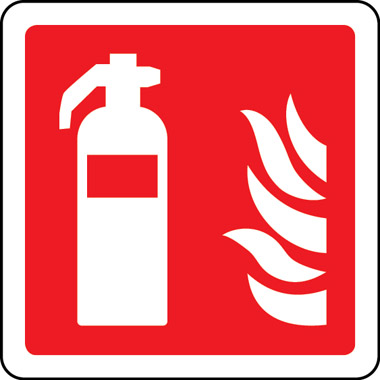Types of Extinguishers

Fire extinguishers are designed to tackle specific types of fire. There are six different classes of fire and several different types of fire extinguishers.
Classes of fire
- Class A – fires involving solid materials such as wood, paper or textiles.
- Class B – fires involving flammable liquids such as petrol, diesel or oils.
- Class C – fires involving gases.
- Class D – fires involving metals.
- Class E – fires involving live electrical apparatus. (Technically ‘Class E’ doesn’t exists however this is used for convenience here)
- Class F (or K) – fires involving cooking oils such as in deep-fat fryers.
Types of extinguishers
 |
Water extinguishersWater extinguishers are one of the most cost-effective ways to fight Class A fires, those fuelled by solid materials such as paper, wood and textiles. There are four different types of water extinguishers: water jet, water spray, water with additives and water mist or fog.
Label: All water extinguishers have a red label. Application: Class A |
 |
Foam extinguishersFoam fire extinguishers can be used on Class A and B fires. They are most suited to extinguishing liquid fires such as petrol or diesel and are more versatile than water jet extinguishers because they can also be used on solids such as wood and paper. The foam extinguishes liquid fires by sealing the surface of the liquid, preventing flammable vapour reaching the air and starving the fire of fuel. They are not suitable for use on free flowing liquid fires. Label: Foam extinguishers have a cream label. Application: Class A, B |
 |
Dry Powder extinguishersPowder extinguishers are a good multi-purpose fire extinguisher because they can be used on Class A, B and C fires. They can also be used on fires involving electrical equipment however, they do not cool the fire so it can re-ignite. Powder extinguishers can also create a loss of visibility and may create breathing problems. They are not generally recommended for use inside buildings unless there is absolutely no alternative. Label: Powder extinguishers have a blue label. Application: Class A, B, C |
 |
Carbon dioxide extinguishers (CO2)CO2 extinguishers are ideal for places with a lot of electrical equipment such as offices or server rooms because they are safe to use on fires involving electrical apparatus. Carbon dioxide extinguishers do not leave any residue, unlike a foam extinguisher. They can also be used on Class B fires, those involving flammable liquids such paraffin or petrol. CO2 extinguishers work by smothering the fire and cutting off the supply of air. Label: Carbon Dioxide Extinguishers (CO2) have a black label. Application: Class B, C |
 |
Wet chemical extinguishersWet chemical extinguishers are suitable for use on Class F fires involving cooking oils and fats, such as lard, olive oil, sunflower oil, maize oil and butter. They are extremely effective, when used correctly. The wet chemical rapidly knocks the flames out, cools the burning oil and chemically reacts to form a soap-like solution, sealing the surface and preventing re-ignition. Although they are primarily designed for use on Class F fires, cooking oils and deep fat fryers. They can also be used on Class A fires (wood, paper and fabrics) and Class B fires (flammable liquids). Label: Wet chemical extinguishers have a yellow label. Application: Class F (or K) |

